What's in a name? It turns out quite a bit, judging from what has taken place lately with Confederate and colonial figures and their names and statues being challenged and removed from public places all over the world. But how do these events touch me and other members of the York University community? This is the question I pose in this reflection. Could it be, I ask myself, that York University's name is also connected with colonialism, and, if so, what implications does it have for the university and what it stands for?

York University name and coat of arms. By Andrevruas - Own work, CC BY-SA 3.0, https///commons.wikimedia.org/w/index.php?curid=31134554
This is what I found out about the name York. The name York comes from the Duke of York, a noble title in the United Kingdom that was created in 1385. Since the 15th century, the title has been granted to the second son of English or British monarchs, and the Dukes are now memorialized in several places in the Commonwealth. In honour of one of them, Frederick Augustus (1763-1827), a monument, costing over one million pounds in today’s currency, stands in Waterloo Place and Gardens in London.
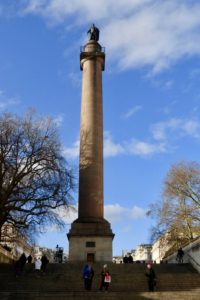
Duke of York Column, London. Carolyn Gifford. https://www.flickr.com/photos/carolyn_gifford/26895037708/in/photolist-GYC6GG-22L9ieN-GYCehG-21yBscy-21yBpJY-21yBqcS-NtFGW7-fGqTFs-bSQhVF-bDTZno-qk4oib-23eKCvL-ntoHwF-23eKCT9-bDVzVY-bUs9cb-bDVzUQ-8M2F8T-bUs9a9-R8PmHc-bDVzKw-bUrS8A-VioWvC-7Fhd4G-dF36Sd-XVFhk4-bEdfKE-8iR9bw-bSQhU6-Sq1qBz-8jWu4Y-bUruo1-bUruqs-eBVUHa-qCvLP5-bUrSaE-7FdjiR-bSQhWT-C4PiYR-bT5DPR-25cUW6x-dQp1Z7-p5AE8x-TjkesA-9wGX8x-bUrS6y-bUrS2C-875GQN-nRMM4G-22GaFV5/lightbox/
And here in Toronto, the Lieutenant-Governor of Upper Canada, John Graves Simcoe, named the second capital of the colony of Upper Canada the “Town of York” after the same Frederick in 1793, a name that remained until the formation of the City of Toronto in 1826.
But the name York and the legacy of Frederick did not disappear with the formation of the City of Toronto. The Toronto region is still peppered with the name, some examples include York Region, North York, Yorkville, East York, Spirit of York Distillery and York Appliance Vacuums. There is also a string of pubs called the Duke of York, a Duke of York Boulevard in Mississauga, and a Duke of York Street in Markham.
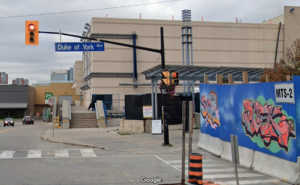
Duke of York Boulevard in Mississauga.
At York University, the adoption of the name was by no means a given. The founders of the university first adopted the name Kellock University after the first president of the North Toronto YMCA, the YMCA being an agency that was initially involved in the planning of York and many other Canadian universities. But at one point the acting president of the University of Toronto, Moffatt Woodside, a classicist, proposed that the university should be named after its locale, York County, rather than an individual. Ironically, though, York County itself, as the colonial capital before it, were named after an individual, Frederick, the Duke of York, an historical fact that escaped Woodside and the rest of the organizing committee.
The Dukes of York have typically entered the military service, which included Frederick, who distinguished himself by reorganizing the army into a more efficient organization. But, along the way, he also performed miserably in several battles and holds the distinction of being featured and mocked in the song “Oh, the noble Duke of York, he had ten thousand men, etc.” He was also a philanderer and gambler who was perpetually in debt. Andy McSmith writes about the Duke being involved in “sex, bribery, betrayal, a royal feud and more sex,” the only thing missing from the story being “a tabloid press to titillate the nation.” This is the institution and the man who all things named York in the Toronto area owe their names to, and that we don’t think twice about exploring or questioning.
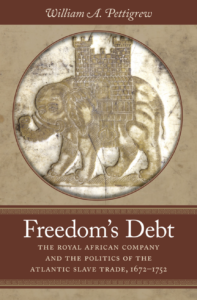
Cover of William Pettigrew's book on the history of the Royal African Company.
I haven’t investigated all the other Dukes of York but there are others who soil the institution. One is particularly relevant as I write these words in yet another climate of anti-Black racism and police brutality in the United States and Canada. The Duke of York who became James II of England (1685-1689), founded the Royal African Company, Britain’s largest slave empire that branded slaves DY after the Duke and transported some 90,000 to 100,000 slaves from Africa to the Caribbean and the American colonies from 1672 to 1689.
But then there is the current Duke of York, of course, Prince Andrew, who, like Frederick, is a military man, who flew a helicopter in the Falklands War and at one point in his life was a globetrotter (Air Miles Andy) and party-goer (“Party Prince”) until his brief marriage to Sarah Ferguson. Since his divorce in 1996, he resumed the travelling and party circuit and, among other things, struck up his infamous relationship with Jeffrey Epstein. Epstein is the disgraced financier, socialite and convicted sex offender who allegedly killed himself in prison on August 10, 2019. He was featured in the Netflix mini-series Jeffrey Epstein: Filthy Rich that launched in the early summer of 2020. When watching it, I was appalled by the impunity and length and extent that Epstein operated his predatory scheme and his close connections with powerful people, like Prince Andrew, Bill Clinton, and Donald Trump. Prince Andrew stands accused of sleeping with a 17-year old girl solicited through his connection with Epstein. Though Andrew went on public television denouncing the accusation, there is no denying his liaison with Epstein, even meeting with him after Epstein served jail time for sex offences. The British media described his interview as a “car crash.” There are brief segments of the interview in the Netflix series where Andrew appears as less than credible, and where witnesses attest to his liaison with the young woman.
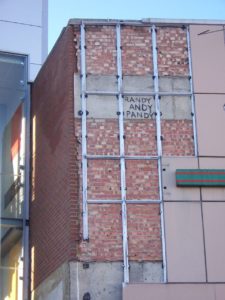
Graffitti mocking Prince Andrew, the Duke of York. sarflondondunc licensed under CC BY-NC-ND 2.0
Some argue that men like Frederick and James should be judged and celebrated by the standards of their time rather than by today’s societal conventions. Dukes, after all, will be dukes. But, thankfully, things are changing. Since the story of Prince Andrew broke, the critiques of the prince have been massive. The global auditing firm KPMG, Barclays and Astra-Zeneca, for example, quickly withdrew their support from Pitch@Palace, a Dragon’s Den-type mentoring program founded by the prince. And, then, in February, 2020, Pitch@Palace removed the prince from the very program he had founded. And at Huddersfield College, where the Prince was Chancellor, the students passed a motion asking the prince to resign his position. In response, the University Administration at first defended the prince, but then reconsidered its position. However, they did not need to take action because a few days later Andrew resigned his position. Andrew has also stepped back from royal duties because of the major disruption to the Royal Family caused by the Epstein scandal.
In Canada, some organizations have disassociated themselves from Andrew, including the Trustees of Lakefield College, the Canadian Canoe Museum, the Royal Victoria Yacht Club, and the SickKids Foundation. But Andrew is still the first colonel in chief of one of Canada’s oldest military regiments, the Queen’s York Rangers, a position he earned in a display of soldiers in historical uniforms, replica muskets, and swords dating back 200 years that took place at the Fort York Armoury in Toronto in 1999. In 2014, Andrew was back with the Rangers for a one-day event, celebrating four new battle honours for the Queen. Andrew maintains positions, many of them honorary, on other organizations, including the Empire Club of Toronto, the Monarchist League of Canada, the Royal Highlands Fusiliers, the Princess Louise Fusiliers, the Canadian International Air Show, and the Royal United Services Institute of Alberta.
Then there are many other organizations and places that carry the institutional name of the Duke of York. When speaking in Aurora in 2014, the Prince reportedly mused, “York seems to be a recurring theme here … noting his title, York Region, the Queen's York Rangers, of which he is Colonel in Chief, and the United Kingdom's Yorkshire Regiment, in which he serves the same role.” York University, of course, falls into the same category.
There are also several addresses that carry Andrew’s names, including Prince Andrew Place in Don Mills, Prince Andrew Drive in Caledon, Prince Andrew Court in St. Catharines, and Prince Andrew High School in Dartmouth, Nova Scotia. There is currently a petition to rename the Dartmouth high school after Heidi Stevenson, the RCMP officer who recently died in the line of duty to stop the murder attacks in Nova Scotia.
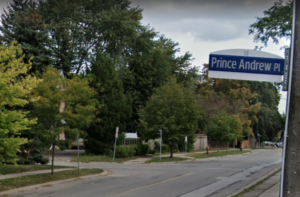
Prince Andrew Place in Don Mills.
What does it mean that places called York in the Toronto region and beyond owe their name to the institution of the Duke of York? Does it matter? Is it fair to draw attention to the connections between the title of the Duke and its holders (including Andrew) and the places, institutions and businesses that are named York? Does the fact that the title has fallen into disrepute by the incumbent touch them? Or, can they disconnect from this nomenclatural string by the significance of their own achievements, that is, can they say, legitimately, there are three degrees of separation between them, the institution of the Duke of York, and Prince Andrew?
Critical toponymy is the academic pursuit of understanding the political, economic and ideological power associated with the naming of places and institutions. It prompts us to examine and ask hard questions about namings, such as York, that we have come to use and accept without question in the everyday. It typically reveals that namings are not innocent and eternal but do have beginnings, often (too) long lives, and perhaps ends. In reference to the many names transposed by colonialism that are still with us today, Harley refers to them as a form of toponymic imperialism. It prompts us to ask why we frequently use certain set of names, like those of dead and even live white wealthy males (with often compromised histories), and not very often others, such as those of prominent women or Indigenous or Black people, or why not, Indigenous or Black women. That is why we should have conversations and ask hard questions about them.
Could this lead to a change in name of places named York? Why not? For York University, it would be a bold, courageous and innovative move coming from an institution that claims to be progressive and supportive of social justice.



